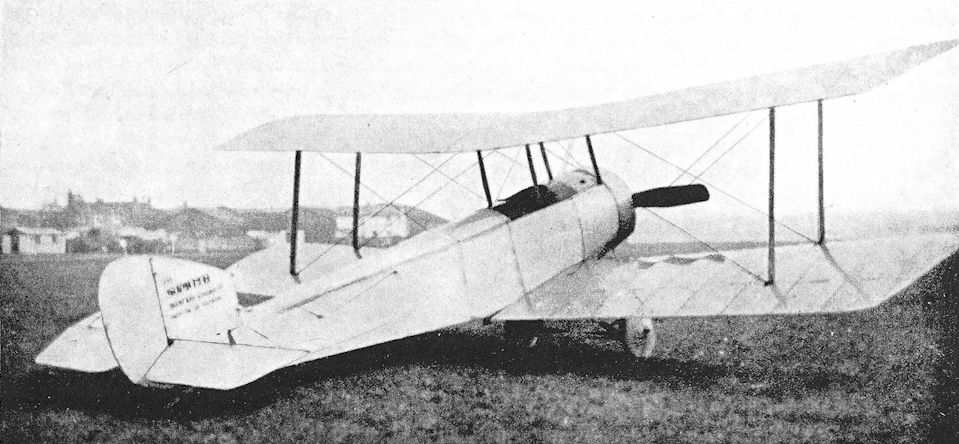H.King Sopwith Aircraft 1912-1920 (Putnam)
SL.T.B.P.
Of the various Sopwith aeroplanes which (men associated with them have assured the present writer over the years) were 'chalked out on the floor of the Experimental Shop by/for Harry Hawker etc. etc' (see also under 'Bee') this little, though evidently larger, precursor of the Pup appears to have the strongest claim to that dubious distinction. That Hawker laid down the general lines of the design, by dictation if not by draughtsmanship, can be accepted; and that he used this 'light tractor biplane' for that nomenclature is implicit in the designation given above - as a 'runabout' is wholly credible. The name 'Hawker's Runabout' appears, indeed, to have gained general currency, though Hawker used it also for aerobatics.
Hardly less certain is the notion that Hawker's personal ideas for a single-seat fighter were developed possibly with the intention of having a Lewis gun on the high-set top wing while he was flying this aeroplane during 1915. A Lewis gun scheme, in fact, may well have had a special appeal to him, particularly when flying near Brooklands; for it was in this same area (at Bisley) that the Lewis gun had first been demonstrated in England by BSA and where Harry's own father is said to have shot, with a rifle, for Australia. (This last asseveration notwithstanding, the name Hawker does not appear among winners of the Queen's Prize between 1860 and 1900 as, according to one account, it should have done).
Upward view for possible combat may certainly have been less in Harry Hawker's early thoughts than armament, though lightness and simplicity were targets clearly shared with Sigrist and the drawing office staff. Lightness was implicit in the installation of a low-powered engine a 50 hp Gnome (the actual one, it was said, from the Burgess-Wright bought by Tom Sopwith in 1911), this unit being cantilevered from a single rear mounting and having a circular cowling, quite different from the 'fish-mouth' of the Tabloid. (The term 'cantilevered' here implies that the engine had a circular bearer-plate, or plates, boiled directly to an engine-bearer in the fuselage, and leaving the front end of the crankshaft unsupported - the rear end being located by a transverse member in the fuselage. This last-mentioned member also resisted any bending moments tending to pull the engine out of alignment).
Simplicity was proclaimed by adherence to wing-warping for lateral control. Of hardly less significance (the deficiency in upward view having earlier been intimated) was the sharp stagger of the wings, with evident advantages to forward and downward fields of vision. Rearward rake on the tips of the wings and tailplane were other features portending the Pup, though the narrow-span centre section was carried on vertical (not splayed-out) struts.
Concomitant with lightness and simplicity were aerodynamic cleanness and an air of daintiness - characteristics evident in the photographs, which, truth to tell, contribute most of the information which might usefully be added in this text. One exception to this honest declaration is evidence that, with an 80 hp Le Rhone or 100 hp Gnome Monosoupape engine, a second seat and ailerons instead of wing-warping, the airframe still existed in 1926.
J.Bruce British Aeroplanes 1914-1918 (Putnam)
Sopwith Biplane Type SL.T.B.P.
THIS little single-seater was built in 1915. It was produced for the personal use of Harry Hawker, the Sopwith company’s great test pilot. He used it as a means of transport between the various aerodromes at which the products of sub-contractors for Sopwith types were tested.
Hawker himself had a good deal to do with the design of the aeroplane. Since production was not contemplated, no ordinary drawings were produced. Instead, full-size drawings were chalked by Hawker on the floor of the Experimental Shop in the Sopwith factory at Canbury Park Road, Kingston-on-Thames, and the machine was built on top of these chalk drawings.
Simplicity was the keynote of the design. The completed aeroplane emerged as a single-bay biplane powered by a 50 h.p. Gnome engine and characterised by clean lines and orthodox construction. The wings had pronounced stagger, and the plan-form of the tips showed a distinctive backwards rake. Wing-warping was used for lateral control.
The fuselage was a conventional wire-braced wooden structure. The undercarriage was of the Sopwith split-axle type, and the fin and rudder were also typical of Sopwith design. The tailplane echoed the shape of the wing-tips, for its extremities were similarly raked backwards.
Hawker flew the little single-seater a great deal, and used it regularly until the Sopwith Bee was built for him. It is quite remarkable that the SL.T.B.P. survived the war and was still in existence in 1926. By then it had been converted into a two-seater and was fitted with an 80 h.p. Le Rhone engine, whilst ailerons had replaced the original wing-warping system.
Although this little single-seater’s only direct contribution to the war was to expedite Hawker’s testing work by enabling him to travel quickly from one aerodrome to another, it was yet of great historical importance. It was the fore-runner of the Sopwith Pup, and its design contained many features which later appeared on that great fighter.



